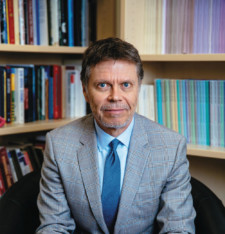Continuing to Get Straight the Facts About the American Economy

The barrage of mistaken claims about long-term economic trends affecting ordinary Americans is unremitting. So too, therefore, must corrections of these claims be unremitting. One especially vivid correction is Art Carden’s recent reflection on Elvis Presley’s Graceland mansion. As Art argues, comparing Elvis Presley’s mid-1970s lifestyle to that of middle-class Americans today provides powerful evidence against conventional wisdom which holds that economic growth has for the past half-century benefited only the superrich.
Extensive empirical support for Art’s argument appears throughout Phil Gramm, Robert Ekelund, and John Early’s (GEE’s) excellent 2022 book, The Myth of American Inequality. In my previous column I highlighted some of GEE’s findings. Here are some other notable ones.
Sources of Americans’ Income
Anyone who read Thomas Piketty’s 2014 Capital In the Twenty-First Century can be forgiven for concluding that very large portions of the incomes of the superrich in capitalist societies come from returns on investments. The picture painted by Piketty is of economic oligarchs lazing about in their mansions or on their yachts indolently soaking up wealth that oozes automatically from capital, much of which was inherited, This wealth is routinely passed on by the idle rich to their idle and even richer children. Meanwhile, most of the world’s labor is performed by increasingly impoverished workers who own nothing but their hands, backs, and brawn. The only hope for ordinary people is for governments to change their dastardly ways by starting, finally, to heavily tax the rich and to give most of the proceeds to the non-rich.
Yet nothing about this picture is accurate. Here’s are data-supported conclusions about the United States reported by GEE:
Income from savings and investing in 2017 remained a small fraction of total earned income up to the 99th percentile of households. Even up through the 99.99th percentile, saving and investing generated less than half of household income…. [E]ven for the top four hundred highest-earning households, wages, salaries, and benefits still created more than 20 percent of their earned income.
The fact that income from work is the dominant determinant of earned income for 99.99 percent of all households in America has significant implications. Prosperity for all but a tiny outlier group of very-high-income households comes from normal, everyday work. And even most of the earnings from savings and investing are the results of saving from previous work income. A recent study of millionaires (households with a net worth of more than $1 million) discovered that only 21 percent of them had received any inheritance. Only 16 percent inherited more than $100,000, and only 3 percent inherited $1 million or more. Yes, a few people inherited wealth, but the vast majority earned it first and then saved it.
As for Piketty’s insistence that, in free markets without massive ‘redistributive’ taxation, the greater the amount of wealth that a person or family possesses, the faster it will grow relative to that of smaller amounts of wealth, GEE report that
[o]n average, the wealth of Forbes 400 members, alumni, and their descendants grew five percent less per year than the returns that would have accrued to the typical conservative investor in stocks and bonds over the same period.
But the Rich Pay In Taxes Less Than Their Fair Share!
But don’t America’s poor pay an unfairly high percentage of their income in taxes while America’s rich pay an unfairly low percentage? Such, after all, is what is claimed to be found by economists Emmanuel Saez and Gabriel Zucman, each of whom received the American Economic Association’s prestigious John Bates Clark Medal.
No. Saez’s and Zucman’s claims about the burden of taxation across income earners is wildly inaccurate. As GEE note about the research of Saez and Zucman,
[t]hey count only earned income. They completely ignore transfer payments that make up more than 90 percent of the income of the bottom quintile and 50 percent of the income of the second quintile. By not counting transfer payments as income to the recipient households, they grossly understate income in the bottom two-fifths of the population. So, when they then divide the actual taxes paid by an income amount that is between two and nine times smaller than the real amount, the result tax rates are unbelievably too high….
For the lower part of the income distribution, they choose not to count the largest part of the actual income individuals actually received – namely, transfer payments. At the higher end of the distribution, Saez and Zucman decide to count fictional amounts that the households never received as income. They estimate how much assets by individuals might have appreciated. These assets may include stock, mutual funds, retirement accounts, art collections, or homes. Then they count that amount as if it were income, although the asset owners cannot use it for consumption, savings, or paying taxes because they never received it.
After adjusting household-income figures to include government transfers, but not to include unrealized (and often only estimated) appreciations in capital values, GEE find that income-tax filers in the bottom half of income earners pay, as federal income and payroll levies, on average about nine percent of their incomes. In contrast, income-tax filers in the top ten percent of income earners pay in these taxes on average about 21 percent of their incomes. The average tax-payment figure for income-tax filers in the top one percent is about 28 percent of their incomes. (These figures are all pre-COVID.)
The data simply contradict the popular claim that high-income Americans, compared to lower-income Americans, do not pay substantially higher portions of their incomes as taxes to the federal government.
Fifty Years of Immense Economic Improvement for Ordinary Americans
Despite governments at the local, state, and federal levels all obstructing, in various ways, the process of entrepreneurial wealth creation, the robustness of the American economy continues to impress. As reported by GEE about the years 1967-2017:
Health insurance for the top quintile would usually have covered only hospitalization in 1967, but most of the poorest households in the land now get full, first-dollar coverage without any cost sharing. Even with full coverage, the poorest today are still about 20 percent less likely to need hospitalization than their rich predecessors in 1967 because of improved treatments. When people at any income level go to the hospital, they will stay only a fraction of the time spent in 1967, are more likely to emerge fully restored, and are far less likely to be readmitted with the same complaint. An average lower-income person in 2017 will live eight years longer than a top-quintile person did in 1967….
If you were an adult fifty years ago, think about the 20 percent of the homes in your hometown – not the top 10 percent or the top 1 percent but the homes that were comfortable but less than mansions. They were the only homes with central air conditioning and two or more full bathrooms. Today, most families classified as poor have both.
In 1967, the middle quintile might vacation in the family car or by bus, the top quintile might fly, mostly in a prop plane. Today, cheap tickets are used by people in all income brackets to jet throughout the nation and, increasingly, throughout the world. And if they choose to travel by car, the Cadillacs and Rolls-Royces of the crème de la crème 1967 broke down ten times more often than the Ford owned by a bottom-quintile family in 2017. The Ford will also last twice as long and be four times safer.
The picture painted from rich sources of data by Gramm, Ekelund, and Early reveals an American economy that over the past several decades steadily and surely raised the real incomes of Americans across the income distribution. This picture is encouraging. But a word of caution is in order. Most of GEE’s data end in 2017. Although that’s only six years ago, those six years were unusually bad ones for economic prosperity. Starting in early 2018 Americans have been subjected to recurring waves of protectionism – waves started by Donald Trump and continued by Joe Biden. Because no small part of our growing prosperity up through 2017 was caused by our greater integration into the global economy, today’s fever for protectionism – a fever prevalent now across the political spectrum – will surely dim, and perhaps severely darken the economy’s prospects going forward. Also worrisome is the current craze of politicians of all stripes with active antitrust enforcement. By penalizing innovative experimentation with different business models, the recent rise of antitrust activity will join protectionism in stymying economic growth.
Far worse, however, is the terrible precedent set by America’s, and most other governments’, authoritarian posture during COVID. Although COVID restrictions are now largely things of the past, no one can know just how much entrepreneurial energy is still being sapped away by uncertainty about what will happen when another contagious pathogen emerges – as one will. Having learned how easy it is to frighten people into sheepish obedience to diktats that shut down large swathes of the economy indefinitely, governments are very likely to pull such a stunt again. Even just the prospect of enduring yet another fear-fueled authoritarian lockdown might very well be draining would-be entrepreneurs of much of the optimism they need to energize their productive endeavors.
Let us hope that at least we Americans soon recover from our infatuation with government power.










